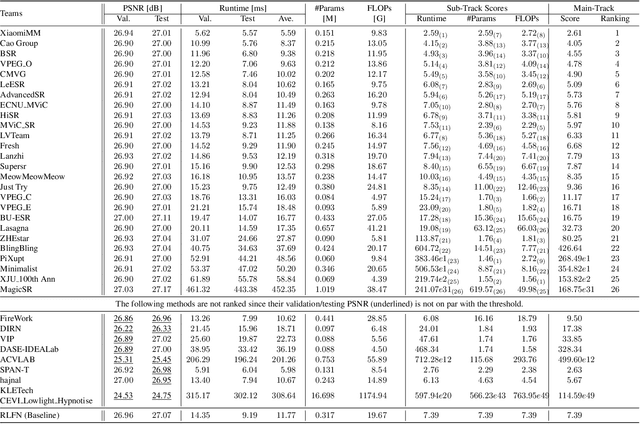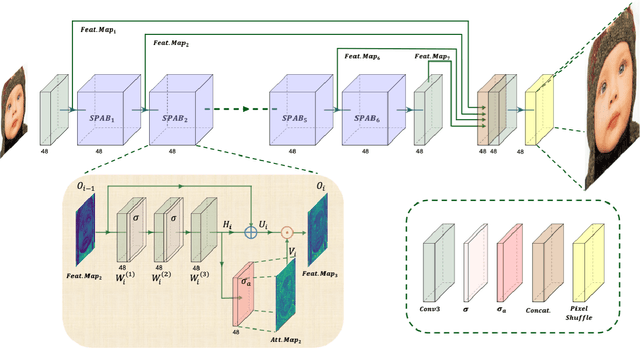Peizhe Xia
Pixel to Gaussian: Ultra-Fast Continuous Super-Resolution with 2D Gaussian Modeling
Mar 09, 2025Abstract:Arbitrary-scale super-resolution (ASSR) aims to reconstruct high-resolution (HR) images from low-resolution (LR) inputs with arbitrary upsampling factors using a single model, addressing the limitations of traditional SR methods constrained to fixed-scale factors (\textit{e.g.}, $\times$ 2). Recent advances leveraging implicit neural representation (INR) have achieved great progress by modeling coordinate-to-pixel mappings. However, the efficiency of these methods may suffer from repeated upsampling and decoding, while their reconstruction fidelity and quality are constrained by the intrinsic representational limitations of coordinate-based functions. To address these challenges, we propose a novel ContinuousSR framework with a Pixel-to-Gaussian paradigm, which explicitly reconstructs 2D continuous HR signals from LR images using Gaussian Splatting. This approach eliminates the need for time-consuming upsampling and decoding, enabling extremely fast arbitrary-scale super-resolution. Once the Gaussian field is built in a single pass, ContinuousSR can perform arbitrary-scale rendering in just 1ms per scale. Our method introduces several key innovations. Through statistical ana
$\text{S}^{3}$Mamba: Arbitrary-Scale Super-Resolution via Scaleable State Space Model
Nov 16, 2024Abstract:Arbitrary scale super-resolution (ASSR) aims to super-resolve low-resolution images to high-resolution images at any scale using a single model, addressing the limitations of traditional super-resolution methods that are restricted to fixed-scale factors (e.g., $\times2$, $\times4$). The advent of Implicit Neural Representations (INR) has brought forth a plethora of novel methodologies for ASSR, which facilitate the reconstruction of original continuous signals by modeling a continuous representation space for coordinates and pixel values, thereby enabling arbitrary-scale super-resolution. Consequently, the primary objective of ASSR is to construct a continuous representation space derived from low-resolution inputs. However, existing methods, primarily based on CNNs and Transformers, face significant challenges such as high computational complexity and inadequate modeling of long-range dependencies, which hinder their effectiveness in real-world applications. To overcome these limitations, we propose a novel arbitrary-scale super-resolution method, called $\text{S}^{3}$Mamba, to construct a scalable continuous representation space. Specifically, we propose a Scalable State Space Model (SSSM) to modulate the state transition matrix and the sampling matrix of step size during the discretization process, achieving scalable and continuous representation modeling with linear computational complexity. Additionally, we propose a novel scale-aware self-attention mechanism to further enhance the network's ability to perceive global important features at different scales, thereby building the $\text{S}^{3}$Mamba to achieve superior arbitrary-scale super-resolution. Extensive experiments on both synthetic and real-world benchmarks demonstrate that our method achieves state-of-the-art performance and superior generalization capabilities at arbitrary super-resolution scales.
QMambaBSR: Burst Image Super-Resolution with Query State Space Model
Aug 16, 2024



Abstract:Burst super-resolution aims to reconstruct high-resolution images with higher quality and richer details by fusing the sub-pixel information from multiple burst low-resolution frames. In BusrtSR, the key challenge lies in extracting the base frame's content complementary sub-pixel details while simultaneously suppressing high-frequency noise disturbance. Existing methods attempt to extract sub-pixels by modeling inter-frame relationships frame by frame while overlooking the mutual correlations among multi-current frames and neglecting the intra-frame interactions, leading to inaccurate and noisy sub-pixels for base frame super-resolution. Further, existing methods mainly employ static upsampling with fixed parameters to improve spatial resolution for all scenes, failing to perceive the sub-pixel distribution difference across multiple frames and cannot balance the fusion weights of different frames, resulting in over-smoothed details and artifacts. To address these limitations, we introduce a novel Query Mamba Burst Super-Resolution (QMambaBSR) network, which incorporates a Query State Space Model (QSSM) and Adaptive Up-sampling module (AdaUp). Specifically, based on the observation that sub-pixels have consistent spatial distribution while random noise is inconsistently distributed, a novel QSSM is proposed to efficiently extract sub-pixels through inter-frame querying and intra-frame scanning while mitigating noise interference in a single step. Moreover, AdaUp is designed to dynamically adjust the upsampling kernel based on the spatial distribution of multi-frame sub-pixel information in the different burst scenes, thereby facilitating the reconstruction of the spatial arrangement of high-resolution details. Extensive experiments on four popular synthetic and real-world benchmarks demonstrate that our method achieves a new state-of-the-art performance.
The Ninth NTIRE 2024 Efficient Super-Resolution Challenge Report
Apr 16, 2024



Abstract:This paper provides a comprehensive review of the NTIRE 2024 challenge, focusing on efficient single-image super-resolution (ESR) solutions and their outcomes. The task of this challenge is to super-resolve an input image with a magnification factor of x4 based on pairs of low and corresponding high-resolution images. The primary objective is to develop networks that optimize various aspects such as runtime, parameters, and FLOPs, while still maintaining a peak signal-to-noise ratio (PSNR) of approximately 26.90 dB on the DIV2K_LSDIR_valid dataset and 26.99 dB on the DIV2K_LSDIR_test dataset. In addition, this challenge has 4 tracks including the main track (overall performance), sub-track 1 (runtime), sub-track 2 (FLOPs), and sub-track 3 (parameters). In the main track, all three metrics (ie runtime, FLOPs, and parameter count) were considered. The ranking of the main track is calculated based on a weighted sum-up of the scores of all other sub-tracks. In sub-track 1, the practical runtime performance of the submissions was evaluated, and the corresponding score was used to determine the ranking. In sub-track 2, the number of FLOPs was considered. The score calculated based on the corresponding FLOPs was used to determine the ranking. In sub-track 3, the number of parameters was considered. The score calculated based on the corresponding parameters was used to determine the ranking. RLFN is set as the baseline for efficiency measurement. The challenge had 262 registered participants, and 34 teams made valid submissions. They gauge the state-of-the-art in efficient single-image super-resolution. To facilitate the reproducibility of the challenge and enable other researchers to build upon these findings, the code and the pre-trained model of validated solutions are made publicly available at https://github.com/Amazingren/NTIRE2024_ESR/.
 Add to Chrome
Add to Chrome Add to Firefox
Add to Firefox Add to Edge
Add to Edge